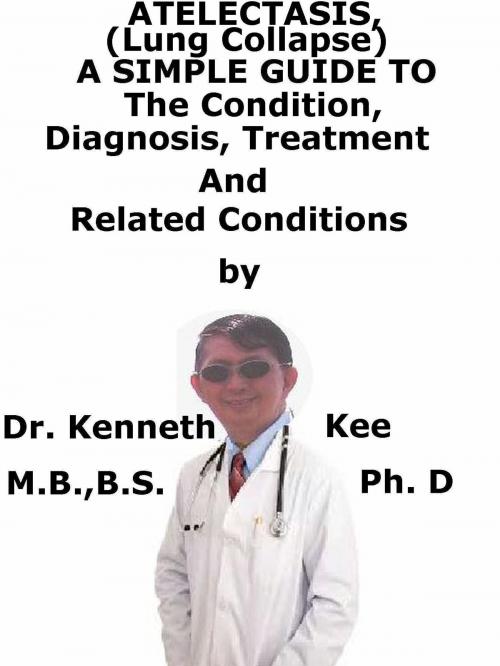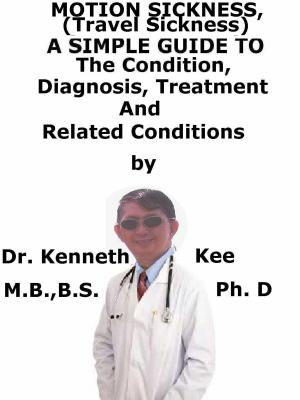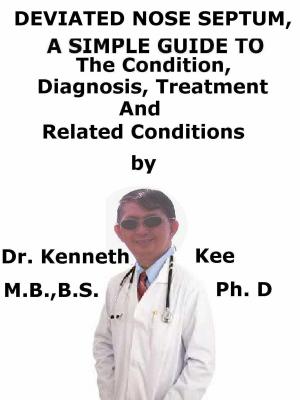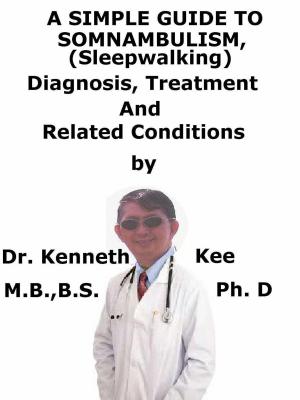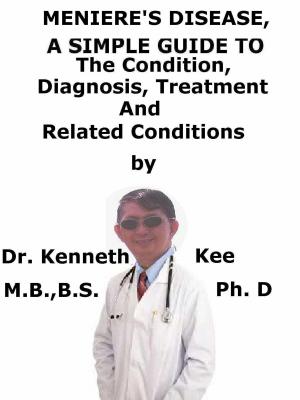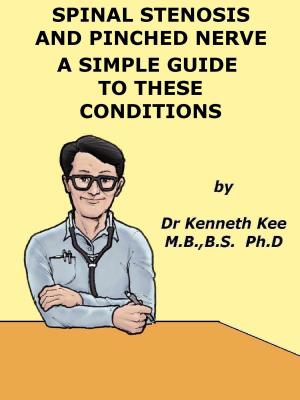Atelectasis, (Lung Collapse) A Simple Guide To The Condition, Diagnosis, Treatment And Related Diseases
Nonfiction, Health & Well Being, Medical, Specialties, Pulmonary & Thoracic, Health, Ailments & Diseases, Respiratory| Author: | Kenneth Kee | ISBN: | 9781370796526 |
| Publisher: | Kenneth Kee | Publication: | October 17, 2016 |
| Imprint: | Smashwords Edition | Language: | English |
| Author: | Kenneth Kee |
| ISBN: | 9781370796526 |
| Publisher: | Kenneth Kee |
| Publication: | October 17, 2016 |
| Imprint: | Smashwords Edition |
| Language: | English |
Atelectasis is the state of incomplete expansion or the collapse of part or airlessness of the lungs due to the failure to expand at birth (atelectasis of the newborn) or (much less commonly) the collapse of part or all of a lung.
Atelectasis of the right lung is more common than the left lung especially in cases of obstruction.
This is because the right main bronchus is straighter than the left bronchus so any foreign body or mucus is more lightly to obstruct the right lung.
Atelectasis can be caused by complications arising out of respiratory illnesses.
It occurs when the alveoli, the tiny air sacs within the lungs, collapsed.
Some of the common causes of atelectasis are severe asthma, chest injuries, cystic fibrosis and congestion due to mucus in the airways.
Oxygen and carbon dioxide exchange in the lungs may be impaired in severe cases.
Acute atelectasis frequently happens after surgery which involves the chest or abdomen.
It may also happen as a result to an injury to the chest.
This form of atelectasis affects most of the alveoli in one or more areas of the lung, with the alveolar sacs collapsing completely.
The risks of acute atelectasis are tight bandages, immobility, chest or abdominal pain or swelling and large doses of opioids or sedatives which increase after surgery or injury.
Chronic atelectasis
a. Right middle lobe syndrome, which is also known as Andy Wilson’s Disease, affects the middle lobe of the right lung.
This alveolar sacs of the right middle lobe lung collapses and contracts due to pressure exerted on the bronchus by enlarged lymph glands.
Pneumonia infection may result leading to chronic inflammation, scarring and bronchiectasis.
b. Rounded atelectasis.
Rounded atelectasis or folded lung syndrome affects the slow collapse of an outer part of the lung.
The scarring and shrinkage of the pleura, the membranes covering the lung, is the main cause.
Rounded atelectasis is frequently linked to asbestos related respiratory diseases.
There are 2 main causes of atelectasis.
1. Obstructive atelectasis due to a blockage of the airways
2. Non-obstructive atelectasis which is caused by pressure from outside the lung.
The signs and symptoms of atelectasis are:.
a. Breathing difficulty including tachypnea
b. Chest pain and tachycardia
c. Cough
The following procedures may be done to confirm atelectasis:
a. Bronchoscopy may check for obstruction by foreign body or scarring of the airways
b. Chest CT scan will show enhanced presence of lung collapse
c. Chest x-ray will show collapse of the lungs or mediastinal shift.
Treatment for atelectasis depends on the cause, with the aim of treatment being to reverse and re-expand the collapse of the lung tissue.
If fluid is causing pressure on the lung, removal of the fluid may help the lung to expand.
A. Several types of chest physiotherapy are also used to treat atelectasis:
a. Clapping (percussion) on the chest to loosen mucus plugs in the airway
b. Deep breathing exercises
c. Remove any blockage in the airways such as foreign body or hardened mucus plugs by bronchoscopy.
d. Tilting the head at a lower level than the chest.
This is a form of postural drainage and helps the accumulated mucus to drain away more easily
e. Turn the person to lie on the healthy side, to allow the collapsed area of lung to re-expand
B. Breathing oxygen helps to relieve shortness of breath
C. Surgery: Atelectasis caused by a tumor may require chemotherapy, radiation therapy or surgery to shrink or remove the tumor
TABLE OF CONTENT
Introduction
Chapter 1 Atelectasis
Chapter 2 Causes of Atelectasis
Chapter 3 Symptoms of Atelectasis
Chapter 4 Diagnosis of Atelectasis
Chapter 5 Treatment of Atelectasis
Chapter 6 Prognosis of Atelectasis
Chapter 7 Bronchiectasis
Chapter 8 Pneumonia
Epilogue
Atelectasis is the state of incomplete expansion or the collapse of part or airlessness of the lungs due to the failure to expand at birth (atelectasis of the newborn) or (much less commonly) the collapse of part or all of a lung.
Atelectasis of the right lung is more common than the left lung especially in cases of obstruction.
This is because the right main bronchus is straighter than the left bronchus so any foreign body or mucus is more lightly to obstruct the right lung.
Atelectasis can be caused by complications arising out of respiratory illnesses.
It occurs when the alveoli, the tiny air sacs within the lungs, collapsed.
Some of the common causes of atelectasis are severe asthma, chest injuries, cystic fibrosis and congestion due to mucus in the airways.
Oxygen and carbon dioxide exchange in the lungs may be impaired in severe cases.
Acute atelectasis frequently happens after surgery which involves the chest or abdomen.
It may also happen as a result to an injury to the chest.
This form of atelectasis affects most of the alveoli in one or more areas of the lung, with the alveolar sacs collapsing completely.
The risks of acute atelectasis are tight bandages, immobility, chest or abdominal pain or swelling and large doses of opioids or sedatives which increase after surgery or injury.
Chronic atelectasis
a. Right middle lobe syndrome, which is also known as Andy Wilson’s Disease, affects the middle lobe of the right lung.
This alveolar sacs of the right middle lobe lung collapses and contracts due to pressure exerted on the bronchus by enlarged lymph glands.
Pneumonia infection may result leading to chronic inflammation, scarring and bronchiectasis.
b. Rounded atelectasis.
Rounded atelectasis or folded lung syndrome affects the slow collapse of an outer part of the lung.
The scarring and shrinkage of the pleura, the membranes covering the lung, is the main cause.
Rounded atelectasis is frequently linked to asbestos related respiratory diseases.
There are 2 main causes of atelectasis.
1. Obstructive atelectasis due to a blockage of the airways
2. Non-obstructive atelectasis which is caused by pressure from outside the lung.
The signs and symptoms of atelectasis are:.
a. Breathing difficulty including tachypnea
b. Chest pain and tachycardia
c. Cough
The following procedures may be done to confirm atelectasis:
a. Bronchoscopy may check for obstruction by foreign body or scarring of the airways
b. Chest CT scan will show enhanced presence of lung collapse
c. Chest x-ray will show collapse of the lungs or mediastinal shift.
Treatment for atelectasis depends on the cause, with the aim of treatment being to reverse and re-expand the collapse of the lung tissue.
If fluid is causing pressure on the lung, removal of the fluid may help the lung to expand.
A. Several types of chest physiotherapy are also used to treat atelectasis:
a. Clapping (percussion) on the chest to loosen mucus plugs in the airway
b. Deep breathing exercises
c. Remove any blockage in the airways such as foreign body or hardened mucus plugs by bronchoscopy.
d. Tilting the head at a lower level than the chest.
This is a form of postural drainage and helps the accumulated mucus to drain away more easily
e. Turn the person to lie on the healthy side, to allow the collapsed area of lung to re-expand
B. Breathing oxygen helps to relieve shortness of breath
C. Surgery: Atelectasis caused by a tumor may require chemotherapy, radiation therapy or surgery to shrink or remove the tumor
TABLE OF CONTENT
Introduction
Chapter 1 Atelectasis
Chapter 2 Causes of Atelectasis
Chapter 3 Symptoms of Atelectasis
Chapter 4 Diagnosis of Atelectasis
Chapter 5 Treatment of Atelectasis
Chapter 6 Prognosis of Atelectasis
Chapter 7 Bronchiectasis
Chapter 8 Pneumonia
Epilogue
